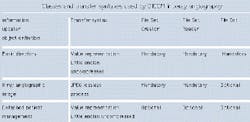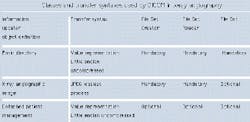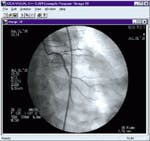Technology Trends: Increased computer power needed to widen image-processing bandwidth
With the introduction of digital diagnostic imaging modalities in the 1970s and the increasing use of computers in clinical applications, the American College of Radiology (ACR; Reston, VA) and the National Electrical Manufacturers Association (NEMA; Rosslyn, VA) recognized the need for a standard method of transferring images and information between devices manufactured by various vendors.
To communicate digital image information and allow the creation of diagnostic information databases, the ACR and NEMA formed a joint committee in 1983. This committee generated an imaging communications standard called DICOM (Digital Imaging and Communications in Medicine). This standard specifies how imaging devices must react to commands and data being exchanged between systems.
Part of the standard specifies how cardiac x-ray angiographic images acquired during cardiac catheterization are to be transferred from acquisition equipment to either a display workstation or a data-archiving system (see table on p.12). To reduce the bandwidth required to transfer these images, a lossless Motion-JPEG (MJPEG) process is used.
In the past, vendors of PC-based compression boards used dedicated hardware based around JPEG compression engines from companies such as Zoran (Santa Clara, CA). Another company, Foresight Imaging (Chelmsford, MA), used to offer such a product, the PCI-based Ice-Clarity board. "But with the introduction of near-gigahertz Pentium CPUs, the whole market for this product evaporated," says Tony Molinari, vice president of marketing and business development at Foresight Imaging.
To address this market, Foresight Imaging has teamed with Pegasus Imaging (Tampa, FL) to co-market its PICTools Medical Compression Toolkit and I-Series frame grabbers (see Vision Systems Design, Sept. 1999, p. 21). Using Foresight Imaging's I-50 frame grabber with the Pegasus lossless JPEG compression software, Foresight Imaging has demonstrated simultaneous 30-frame/s acquisition, display, and storage of 512 x 512 x 8-bit cardiac x-ray cine images.
During operation, x-ray images are captured by the I-50 and transferred over the PCI bus to system memory. There they are compressed in real time and then transferred to an AGP PCI-based RagePro-LT graphics card from ATI Technologies (Thornhill, Ontario, Canada) and simultaneously stored to disk.
PHOTO. Coupling Foresight Imaging's I-50 frame grabber, Pegasus Imaging's MJPEG software, and ATI's AGP graphics card, medical systems developers can configure DICOM-compliant PC-based workstations that capture, store, compress, and display 512 x 512 x 8-bit x-ray cardiac images.
Moreover, Foresight Imaging demonstrated the capability of compressing 1k x 1k x 8-bit cardiac images to disk at 30 frames /s. At this frame rate, the bandwidth of 1k x 1k x 8-bit data is 30 Mbytes/s—within the capability of the PCI bus. And, compressing such data at this rate consumes approximately 85% of the processing power of a 500-MHz Pentium III.
"Unfortunately," says Molinari, "Microsoft's DirectDraw does not support 8-bit data types for display. Instead, it supports a YUV 4:2:2 data format that requires data to be represented as 8-bits of Y and 8-bits of UV data." This approach requires that compressed 8-bit data be converted to 16-bit YUV data before display, effectively doubling the required display bandwidth to 60 Mbytes/s.
This effective 110+ Mbyte/s system bandwidth, coupled to the image-compression and data-conversion tasks, means that, while 1k x 1k x 8-bit images can be compressed in real time to disk, they cannot be simultaneously displayed. Molinari hopes that this bandwidth problem will be overcome in the next few months through the introduction of 1-GHz Pentium processors and 64-bit PCI-bus-based motherboards.


